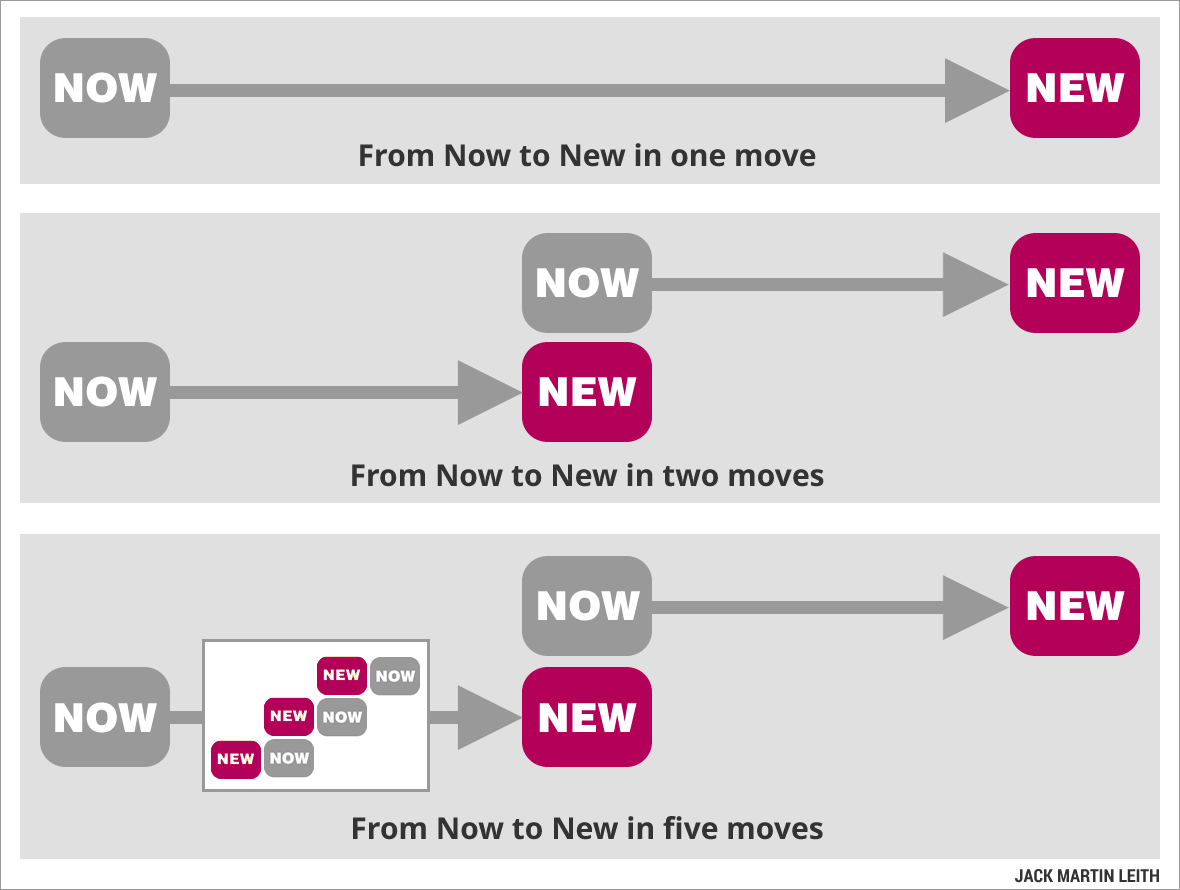Now-to-New refers to a shift from the present situation (Now) to what is needed instead (New).

There are seven kinds of Now-to-New work, which are neither mutually exclusive nor collectively exhaustive:
- Creating
- Transforming problems
- Changing
- Surmounting
- Responding
- Developing
- Realising potential
Creating
Bringing something new into being: a product, service, enterprise, work practice, anything.
Now: There is a need, desire or opportunity to create something that will generate extensive or exceptional value.
New: The new creation exists and is generating the imagined value.
Transforming problems
Restoring and increasing value generation capability.
Whereas problem solving is remedial (aimed at making the problem go away), problem transformation is generative.
Now: A problematic state of affairs exists, value generation capability has been impaired and anti-value is being generated.
New: The generation of anti-value has been halted and value generation capability has been boosted.
Problem-solving is taking actions to have something go away: the problem. While problem-solving has its place, as a persistent approach, it limits accomplishment. The elimination of a problem does not mean that the desired result can be created. As distinguished, solving a problem does not by design lead to a creation. Creating is taking action to bring into being that which does not yet exist: the desired outcome.
Source: Robert Fritz, author of The Path of Least Resistance, in Corporate Tides: The Inescapable Laws of Organizational Structure | Wikipedia — Robert Fritz | Robert Fritz website
Changing
Shifting from the current state of affairs to the desired state.
Now: A different state of affairs is desired.
New: The desired state of affairs prevails.
The state of affairs is the combination of circumstances applying within a society or group at a particular time. The current state of affairs may be considered acceptable by many observers, but not necessarily by all. The state of affairs may present a challenge, or be complicated, or contain a conflict of interest. The status quo represents the existing state of affairs1.
Source: Wikipedia
1. Aka current state of affairs, current situation, current reality, As Is, Now.
Surmounting
Overcoming an overwhelming or seemingly impossible challenge.
Now: There is a need, desire or opportunity to surmount a tough challenge.
New: The challenge has been surmounted.
Responding
Responding to a request or demand.
Now: A request has been received.
New: The request has been fulfilled.
Developing
Increasing value generation capability or value generation potential.
Potential is the what (the possible future yield) and capability is the how (skilled people, equipment, money and other means).
Now: Value generation capability is not at the required level.
New: Value generation capability is at the required level.
Realising potential
Utilising value generation capability or realising value generation potential.
Now: Value generation potential is not being fully realised.
New: Value generation potential is being fully realised.
Some actual Now-to-New projects, selected from my casebook
Client names will be provided on request.
Creating
A global food manufacturer wants to create — overnight — a concept for a new product, inspired and evaluated by potential customers. How can this be achieved?
Changing
A state-owned rail operator in continental Europe intends to shift ticket purchasing from service counters to self-service machines, but the plan is meeting strong opposition from service counter staff. How can this situation be resolved to everyone’s satisfaction?
Transforming problems
The sales and marketing functions of a global corporate are at loggerheads and this is having a negative impact on the business. How might the situation be addressed, such that value generation capability is not only restored, but also expanded?
Surmounting
There is a serious threat of new dog-to-human diseases entering the UK. How can the threat be eradicated?
The contract to provide community arts services in the Welsh valleys has been awarded to an alliance of local authorities. How can the alliance ensure that its ambitious first year goals will be achieved?
Responding
The CEO of a Dublin-based brewer has received a directive from the parent company’s chairman, instructing the brewer’s management team to establish a direct connection with its customers, and not by means of qualitative research. How can this connection be made?
Developing
Members of a specialist unit within a UK government agency have an urgent need to plan, organise and facilitate a series of Open Space meetings, but they lack the specialist skills and very little time is available for training. How can these skills be acquired in a single half-day workshop?
Realising potential
A global oil and gas company needs to find a good use for the water — saline and contaminated with heavy metals — that accompanies oil as it emerges from the subsurface. How might this be accomplished?
From Now to New in one move or multiple moves
Now-to-New work happens sequentially, in parallel, recursively, or all of these. Each successive New becomes the next Now.


Take note that the ‘to’ in Now-to-New does not imply a time interval.
Rather, it denotes a contrivance that turns the current state of affairs (Now) into the desired state of affairs (New) as quickly, effortlessly and unobtrusively as possible, with fewest subordinate moves, and without collateral damage or unintended consequences.
The contrivance may be an intervention, strategy, plan, solution, mission, project, programme of work, or something else.
Continue reading
External websites
The NOW of work: Why wait for the future? Video — runtime 48:14. Niels Pflaeging (Red42, BetaCodex) in conversation with Rijon Erickson
This website
Now-to-New
How the term Now-to-New came into being
Newcreate and other Now-to-New methods
The three kinds of Now-to-New agency: creating alone, creating together and helping others create
Related topics
How does Newcreate compare with design thinking?
Index to entire site (60+ pages)
Search the site
Not case sensitive. Do not to hit return.
